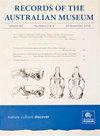天然深海鲸鱼的环节动物群落落在澳大利亚东部
IF 0.8
4区 生物学
Q4 ZOOLOGY
引用次数: 1
摘要
在深海中,鲸鱼的尸体(沉入海底的鲸鱼尸体)在这种食物普遍有限的环境中起到了提高生产力的作用,在分解的各个阶段为鲨鱼和微生物等生物提供营养。环节动物蠕虫是鲸落的习惯性殖民者,从这些环境中定期报道新物种,它们的系统分类有助于解决深海有机落环境中的生物地理格局。2017年,澳大利亚研究船“RV调查员”号在澳大利亚东海岸对深海群落进行深海取样时,偶然地在约1000米的深度处拖网捕获了一个自然的鲸鱼瀑布。在这项研究中,我们使用形态学和分子技术对与鲸鱼坠落群落相关的环节动物进行了详细的分类描述。从这些资料中,我们描述了5科9个新种(蝇蝇科:斑点眼蝇科,斑点眼蝇科,斑点眼蝇科;海蛾科:11月;Neanthes adriangloveri sp. 11月,Neanthes visicte sp. 11月;鸟虻科:鸟虻属(Orbiniella jamesi sp. 11),其中2只属食骨鸟虻属(Siboglinidae: Osedax waadjum sp. nov., Osedax byronbayensis sp. nov.),是首次在澳大利亚海域发现的。我们进一步对两栖科、两栖科、小两栖科、小两栖科、小两栖科、小蜥蜴科、小蜥蜴科、小蜥蜴科、小蜥蜴科、小蜥蜴科、小蜥蜴科、小蜥蜴科、小蜥蜴科和小蜥蜴科的10个分类群进行了系统的统计。我们的调查揭示了独特的现象,并首次使我们能够评估澳大利亚鲸鱼瀑布与西太平洋以及世界各地其他鲸鱼瀑布之间的生物地理联系。本文章由计算机程序翻译,如有差异,请以英文原文为准。
The annelid community of a natural deep-sea whale fall off eastern Australia
In the deep ocean, whale falls (deceased whales that sink to the seafloor) act as a boost of productivity in this otherwise generally food-limited setting, nourishing organisms from sharks to microbes during the various stages of their decomposition. Annelid worms are habitual colonizers of whale falls, with new species regularly reported from these settings and their systematics helping to resolve biogeographic patterns among deep-sea organic fall environments. During a 2017 expedition of the Australian research vessel RV Investigator to sample bathyal to abyssal communities off Australia’s east coast, a natural whale fall was opportunistically trawled at ~1000 m depth. In this study, we provide detailed taxonomic descriptions of the annelids associated with this whale-fall community, using both morphological and molecular techniques. From this material we describe nine new species from five families (Dorvilleidae: Ophryotrocha dahlgreni sp. nov. Ophryotrocha hanneloreae sp. nov., Ophryotrocha ravarae sp. nov.; Hesionidae: Vrijenhoekia timoharai sp. nov.; Nereididae: Neanthes adriangloveri sp. nov., Neanthes visicete sp. nov.; Orbiniidae: Orbiniella jamesi sp. nov.), including two belonging to the bone-eating genus Osedax (Siboglinidae: Osedax waadjum sp. nov., Osedax byronbayensis sp. nov.) that are the first to be described from Australian waters. We further provide systematic accounts for 10 taxa within the Ampharetidae, Amphinomidae, Microphthalmidae, Nereididae, Orbiniidae, Phyllodocidae, Protodrilidae, Sphaerodoridae and Phascolosomatidae. Our investigations uncover unique occurrences and for the first time enable the evaluation of biogeographic links between Australian whale falls and others in the western Pacific as well as worldwide.
求助全文
通过发布文献求助,成功后即可免费获取论文全文。
去求助
来源期刊
CiteScore
0.90
自引率
0.00%
发文量
9
审稿时长
>12 weeks
期刊介绍:
Records of the Australian Museum, volume 62 was published in 2010, volume 63 in 2011. Monographic works of particular significance are published irregularly as Records of the Australian Museum, Supplements (ISSN 0812-7387).

 求助内容:
求助内容: 应助结果提醒方式:
应助结果提醒方式:


